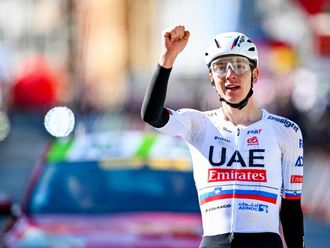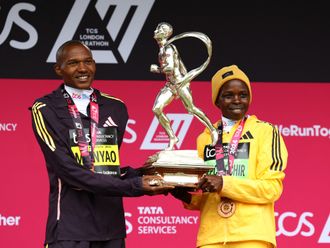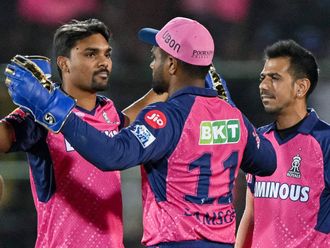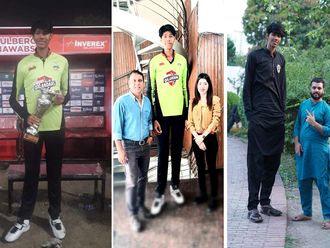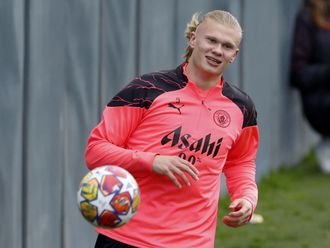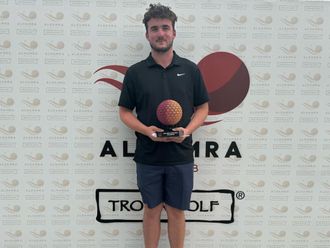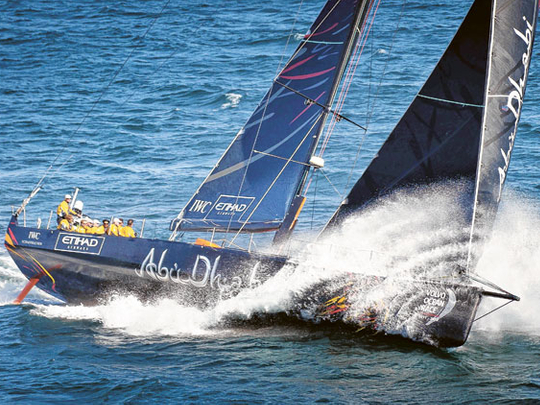
Abu Dhabi: After finishing fourth in the second in-port event of the Volvo Ocean Race, Abu Dhabi Ocean Racing's team's Volvo Open 70 race yacht Azzam is on its way negotiating the 5,430 nautical mile home leg to the UAE capital.
Leading the 11-strong crew is two-time Olympic medallist Ian Walker of Britain, bringing with him more than two decades of sailing experience.
Walker was in Abu Dhabi before flying to Cape Town for the challenging leg in the nine-month Volvo Ocean Race, which started in Alicante, Spain, in October and ends in Galway, Ireland, in early July next year.
Speaking to Gulf News in an exclusive interview, Walker gave some insight into the challenges in an event which is referred to as the ‘Everest of Sailing'.
Gulf News: Among the boats in the fray, how do you look at Azzam's chances?
Ian Walker: We went from the biggest high of winning the in-port race by a good margin to then a huge disappointment and a low of breaking a mast on leg one. So we have experienced two ends of the spectrum and that has helped our cause overall. We have a battle now to catch up with the boats ahead of us.
We still do not know how our boat is going to function. We only saw 100 miles on the first leg. So it looks like we are quite strong in lighter winds as we saw in the in-port race. It is still too early to know. The boats are fairly evenly matched. We have a nice sailing team, we have a nice boat and we are still optimistic.
How many crew members are there on a Volvo Sailing boat?
You need ten people and with all sorts of skills. You need some practical skills like you need someone who knows engineering to help with the rig, so you need to have some practical skills across the crew.
Then on the sailing terms we have two watch captains who run the ‘watches' on board. You have the navigator and skipper-in-charge of the performance and the decision-making and who run their watch on board. Then you have two more helmsmen who, along with the skipper and the two watch leaders, will shadow the steering of the boat. Two guys whose main focus is trimming the sails and getting the best speed from the sails. Two more who spend their time in charge of changing the sails, climbing the mast, and two others who move around doing a bit of everything from trimming the sails to moving equipment.
How are the Emirati crew members on Azzam — Adil Khalid and Butti Al Muhairi — faring?
They have done well. It is easy to forget where they started from. They had never sailed in a big boat. They had never done modern racing at all. Traditional dhow sailing was their background. Now they jump on a boat and there are a number of roles on the boat. They are quite comfortable. Butti in particular is very skilled on the short sail. It has been a long journey and they have come very well and they still have got lots to learn. Also physically they have got much stronger than they were. Lots of the work they do is just hard physical work.
How many days do some of the legs keep the boats sailing?
It depends on the route each year. This year the first five routes are about three weeks long, each of them. Then you have ten days to two weeks ashore.
On a 24-hour scale how long does a crew member get to rest?
At any one point in time we have four people on watch and four people off watch, plus either the skipper or navigator or both. So in theory you do four hours on deck and then you get four hours off watch. So that goes on the whole time — four hours on, four hours off.
The reality is somewhat different when you are off watch. Firstly you have to eat, you have to get undressed and maybe you get into your bed. And then every time you have to change tack or sail you have to get back up to help. So you get quite disturbed off watch or sometimes you get full rest. When it is rough or windy or lots of manoeuvres or sail-changing you can get very tired quite quickly.
How does one keep his motivation and physical fitness at the desired level while on the boat?
One of the most important things is to eat and drink as much as you can. When you don't have fresh food, the food is not very appetising, so it is easy to not eat. But you are working physically 12 hours a day on watch. You need a lot of calories. So it is really important to try and motivate yourself to eat whatever food is put in front of you, whether you like it or not. That is the only source of energy and you have to look after yourself. Even things like cleanliness, there is no shower on board so if you get cuts and bruises they can go septic very quickly. So you have to look after yourself. Some people take an iPod to listen to music, but it is very, very noisy down below.
Which are the new stopovers included this season in the race? Do they throw up new challenges?
Abu Dhabi, Sanya and Auckland are new from the last race. Brazil is new, Miami is new to this race, Brisbane is new, Lorient is new.
Take the leg to America, whether you finish the leg in Miami or Boston, it makes it fundamentally quite different in terms of the last 1,000 miles. It changes the nature of that leg quite a lot. And at the end of the race, because from France and Lisbon, we have quite a few short legs. They are worth the same amount of points as the long legs. A 600-mile leg is worth the same as a three-week leg. It is a good thing for us that we missed a long leg. That may help in some ways — the boys are still fresh, the sails are fresh, so we hope to get some points back.
Which of the legs is the toughest and why?
The toughest leg is sailing from Auckland around the southern ocean around Cape Horn to Brazil. That's the windiest, coldest and the most remote leg. I guess that's the leg the sailors fear the most. In the last race it was my first time around the Cape Horn and I was very nervous as we approached it.




